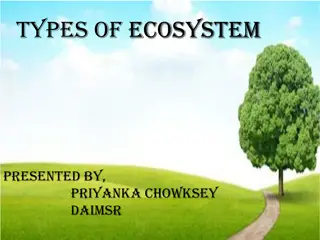Nutrient Recycling in Ecosystems
Nutrient recycling in ecosystems involves the continuous breakdown and exchange of elements between living and non-living components, ensuring sustainability and no long-term drain on Earth's nutrients. This process includes decomposition of organic material by bacteria and fungi, uptake of nutrients by plants, passing through food chains, and eventual return to the abiotic environment for reuse. Similar cycles like the carbon cycle play a crucial role in maintaining nutrient balance and supporting life on Earth.
Download Presentation

Please find below an Image/Link to download the presentation.
The content on the website is provided AS IS for your information and personal use only. It may not be sold, licensed, or shared on other websites without obtaining consent from the author.If you encounter any issues during the download, it is possible that the publisher has removed the file from their server.
You are allowed to download the files provided on this website for personal or commercial use, subject to the condition that they are used lawfully. All files are the property of their respective owners.
The content on the website is provided AS IS for your information and personal use only. It may not be sold, licensed, or shared on other websites without obtaining consent from the author.
E N D
Presentation Transcript
Need to know Define the term: nutrient recycling by organisms. 1. Outline and draw the Carbon Cycle. 2. Outline and draw the Nitrogen Cycle. 2
Nutrient Recycling (1/3) There is a limited amount of nutrients on earth e.g. you are probably aware of the water cycle where water is constantly being recycled in nature. There are similar cycles for all nutrients. When plants and animals die, their nutrient content is not wasted. Bacteria and fungi decompose the remains and release the nutrients back into the abiotic environment (i.e. into the soil, nearby water and air). 3
Nutrient Recycling (2/3) These nutrients are then taken up by other plants and used to make new organic material. This material is passed on down the food chains and is reused by all the chain members. When death occurs for these members, the nutrients are again returned to the abiotic environment and the cycling of nutrients continues in this circular way. 4
Recycling nutrients within an ecosystem Organic Material in Consumers Feeding Breakdown of Organic Molecules in Decomposers Organic Material in Producers Photosynthesis and Chemosynthesis Abiotic Environment Soil and Water 5
Nutrient Recycling (3/3) This ensures that there is no real longterm drain on the Earth s nutrients, despite millions of years of plant and animal activity. 6
In summary Nutrient recycling is the way in which elements are continuously being broken down and/or exchanged for reuse between the living and non-living components of an ecosystem. 7
Carbon Cycle Carbon forms part of all organic nutrients carbohydrates, fats and proteins. Carbon dioxide is removed from the environment by photosynthesis in plants, and under certain conditions, over long periods of time, some of these plants may form fossil fuels such as coal, oil, peat and natural gas. 8
Carbon Cycle Carbon dioxide is returned to the environment by: 1. Respiration in plants, animals & micro- organisms. 2. Decay caused by micro-organisms. 3. Combustion i.e. burning fossil fuels 9
Summary of Carbon Cycle Click on the link below to see a summary of the Carbon Cycle The Carbon Cycle 11
Learning check What is meant by nutrient recycling? Nutrient recycling is the way in which elements are continuously being broken down and/or exchanged for reuse between the living and non-living components of an ecosystem. 12
Learning check What process(es) remove Carbon dioxide from the atmosphere? Photosynthesis What process(es) add Carbon dioxide to the atmosphere? Respiration Decay Combustion 13
The Nitrogen Cycle All organisms need nitrogen for protein, DNA & RNA manufacture 78% of the Earth s atmosphere is nitrogen gas, but it cannot be used in this form by plants and animals. Nitrogen gas must first be fixed , i.e. changed to a suitable form (ammonia or nitrate) before it can be used. 14
Nitrogen Fixation Nitrogen-fixing bacteria in the soil convert N2 gas in the air into ammonia (NH3). This accounts for the majority of all N2 fixation. Lightening storms and fuel burning in car engines produce nitrates, which are washed by rain into the soil water. Nitrates are absorbed by plant roots and converted to plant protein. 15
The Nitrogen Cycle Plant proteins are passed along food chains to become animal protein. When organisms die, their proteins are converted to ammonia by bacterial decomposition. Nitrifying bacteria in the soil then convert ammonia (NH3) into nitrites (NO2 into nitrates (NO3 Nitrates can be absorbed by other plants to continue the cycle. 2 _) then _). 16
The Nitrogen Cycle Denitrifying bacteria convert soil nitrates into N2 gas. This is a loss of N2 from the cycle. Only happens in anaerobic conditions (when O2 levels are low) due to flooding or accumulation of sewage. Nitrate also enters the cycle through the addition of nitrogen rich fertilisers to the soil made industrially from nitrogen gas. 17
Summary of Nitrogen Cycle Click on the link below to see a summary of the Nitrogen Cycle The nitrogen cycle 19
Summary of Nitrogen Cycle Nitrogen in Air NO2 Nitrite Ammonia NH3 6 7 4 1 8 5 5 Nitrate in Soil NO3 Animal Protein 2 Plant Protein 3 1. Nitrogen Fixation & Lightning 2. Absorbed by roots and used by plants Assimulation 3. Animal feeding, digestion & assimulation 4. Excretion: urea Ammonia 5. Death & decomposition putrefying bacteria 6. Nitrification: NH3 NO2 7. Nitrification: NO2 NO3 8. Denitrification: NO3 NO2 N 20
Learning check Nitrogen gas must be fixed what does this mean? Changed to a suitable form (ammonia or nitrate) before it can be used. In what form is nitrogen absorbed by plants? Nitrate 21
Learning check What is nitrification? The conversion of ammonia (NH3) into nitrites (NO2 2 _) then into nitrates (NO3 _). What do denitrifying bacteria do? They convert soil nitrates (NO3 _) into N2 gas. 22
END 23























